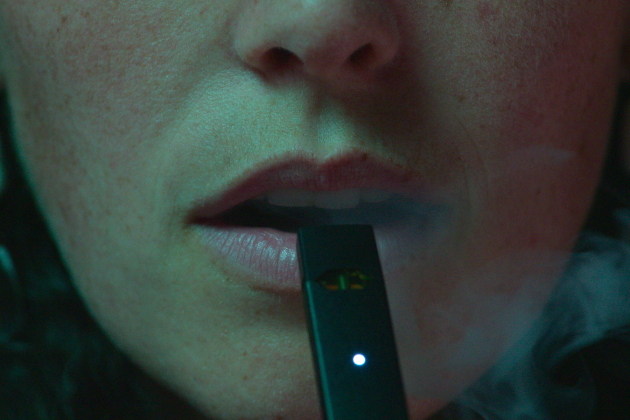Netflix Shows How Juul Went Up in Flames
- Oops!Something went wrong.Please try again later.

Can I hit your Juul? That billion-dollar question whispered in study halls and hollered at house parties among teens and 20-somethings is explored in Netflix’s new documentary series, Big Vape: The Rise and Fall of Juul.
Directed by R.J. Cutler and based on Time reporter Jamie Ducharme’s book Big Vape: The Incendiary Rise of Juul, the four-part series premiering Oct. 11 delves into how the e-cigarette manufacturer became a unicorn company with a $38 billion valuation by hooking young adults, and later went up in flames. Following a series of lawsuits, settlements, and bans, the so-called “iPhone of E-Cigs” quickly became the laughingstock of the smoking world.
More from Rolling Stone
Cutler used to smoke cigarettes. He says it was a nervous habit he picked up as a New York theater director in his 20s ahead of curtain call, but that’s not what drew him to Big Vape. The director behind Billie Eilish: The World’s a Little Blurry and Belushi is drawn to human stories, and believes the unintended consequences of disruptors proved fertile storytelling soil.
“They don’t set out to reignite an epidemic of teen smoking, but the byproduct of their work is that an epidemic of teen smoking is reignited,” Cutler tells Rolling Stone.
The docuseries begins with Stanford tech bros Adam Bowen and James Monsees — who did not participate in the series — as they head out to Silicon Valley to create a startup. After originally bonding over a shared interest in the impact of cigarettes, the two launched Ploom in 2010, a “small, dark, and handsome” e-cigarette powered by butane gas. After selling the company, they amped up nicotine levels and used employees as test dummies for a new product that atomized nicotine salts, providing a far sleeker, far smoother, far more potent (each pod initially contained as much nicotine as an entire pack of cigarettes), far fruitier (flavors included mango and strawberry), and far more cutting-edge (its refillable pods resemble USB flash drives, and devices can be recharged in a USB dock) smoking experience. By May 2015, Juul was born.
“It was indeed founded by these kids coming out of Stanford thinking they’d be the next Steve Jobs,” explains Cutler. “And they had to learn the difficult lesson that a cigarette is not an iPhone. It’s not an Uber.”
By 2018, however, it was ranked the sixth most valuable startup in the U.S., right behind Uber, after raising $650 million in funding that placed its value at $15 billion. Juul accounted for 70 percent of the entire e-cigarette market, and by the end of that year, Altria acquired a 35 percent stake in the company for $12.8 billion, estimating its value to be $38 billion.
A big reason for Juul’s explosion was its popularity among teens and young adults — and the ways the company took advantage of social media to market it to younger customers. The company launched party pop-ups and online hashtags, cooked up ads featuring sexy models Juuling, and purchased advertising in kid- and teen-targeting spaces like Nickelodeon, Cartoon Network, and Seventeen magazine.
According to a report by the attorney general of Massachusetts, Juul also “attempted to recruit celebrities and social media influencers with large numbers of underage followers, such as celebrities like Miley Cyrus, Cara Delevingne, Kristen Stewart, and social media influencers Luka Sabbat and Tavi Gevinson” and “gave out hundreds of free e-cigarettes to celebrities and social media influencers to promote awareness of the JUUL brand and e-cigarette products.” Furthermore, the Massachusetts AG claimed that Juul “illegally sold e-cigarettes to underage consumers through its website without proper age verification.” Between its youth-focused marketing, sleek design, fruity flavors, how easy they were to hide (so its customers could surreptitiously smoke in public), and the (false) perception that they were safer than traditional cigarettes, the pods reigned.

“It was sexy. It was youth-oriented. It looked cool,” offers Cutler. “It was, like it or not, ready-made for social media.”
Ducharme reasons that the brand put a target on its back by selling Juuls as a lifestyle tech device rather than a health gadget. By marketing itself to teenagers as this cool-kid product, they become addicted for a lifetime, which is highly problematic, she says.
“There was also the reputational tarnishing that came from that, and I don’t think Juul to this day has ever really overcome that,” Ducharme tells Rolling Stone.
Big Vape features a collection of anecdotes from former Juul employees and young users, some of whom are still hooked on the pods. The docuseries also examines how the product ignited a public health crisis among young adults, and follows anti-vaping activists, chronicles hospitalizations linked to e-cigarettes, and shows co-founder Monsees testifying in front of Congress on behalf of Juul.
The government soon came after Juul, with the FDA getting their flavored pods discontinued in 2018, and the Center for Environmental Health reaching a settlement with the company. Juul was banned in countries like Israel and India over its high nicotine concentration, and paid out $1.2 billion in December 2022 to settle some 10,000 lawsuits related to its connection with America’s youth-vaping scourge. The company’s value plummeted to just $250 million by the end of last year, and makes up around 37 percent of the e-cigarette market in the U.S.
“I don’t think either of us are here to apologize for Juul,” says Ducharme. “I think very clearly Juul, the company, and the people who founded Juul made many, many mistakes, and could have done countless things differently and more responsibly.”
Best of Rolling Stone

